1. Jang AY, Chung WJ. Current status of pulmonary arterial hypertension in Korea. Korean J Intern Med. 2019; 34:696–707. PMID:
31272141.

2. Oh S, Jung JH, Ahn KJ, et al. Stem cell and exosome therapy in pulmonary hypertension. Korean Circ J. 2022; 52:110–122. PMID:
35128849.

3. Gillmeyer KR, Lee MM, Link AP, Klings ES, Rinne ST, Wiener RS. Accuracy of algorithms to identify pulmonary arterial hypertension in administrative data: a systematic review. Chest. 2019; 155:680–688. PMID:
30471268.

4. Ahn KJ, Jang AY, Park SJ, Chung WJ. 15 years journey of idiopathic pulmonary arterial hypertension with BMPR2 mutation. Clin Hypertens. 2019; 25:22. PMID:
31583114.

5. Choi EK. Cardiovascular research using the Korean National Health Information Database. Korean Circ J. 2020; 50:754–772. PMID:
32725984.

6. Lee HY, Lee SW, Kim HC, Ihm SH, Park SH, Kim TH. Cost-effectiveness analysis of hypertension screening in the Korea National Health Screening Program. Korean Circ J. 2021; 51:610–622. PMID:
34085434.

7. Kim HC, Cho SM, Lee H, et al. Korea hypertension fact sheet 2020: analysis of nationwide population-based data. Clin Hypertens. 2021; 27:8. PMID:
33715619.

8. Ko SH, Han K, Lee YH, et al. Past and current status of adult type 2 diabetes mellitus management in Korea: a national health insurance service database analysis. Diabetes Metab J. 2018; 42:93–100. PMID:
29676539.

9. Cho SM, Lee H, Lee HH, et al. Dyslipidemia fact sheets in Korea 2020: an analysis of nationwide population-based data. J Lipid Atheroscler. 2021; 10:202–209. PMID:
34095012.

10. Gall H, Felix JF, Schneck FK, et al. The giessen pulmonary hypertension registry: survival in pulmonary hypertension subgroups. J Heart Lung Transplant. 2017; 36:957–967. PMID:
28302503.

11. Wijeratne DT, Lajkosz K, Brogly SB, et al. increasing incidence and prevalence of World Health Organization groups 1 to 4 pulmonary hypertension: a population-based cohort study in Ontario, Canada. Circ Cardiovasc Qual Outcomes. 2018; 11:e003973. PMID:
29444925.

12. Anand V, Roy SS, Archer SL, et al. Trends and outcomes of pulmonary arterial hypertension-related hospitalizations in the United States: analysis of the nationwide inpatient sample database from 2001 through 2012. JAMA Cardiol. 2016; 1:1021–1029. PMID:
27851838.

13. Lim SS, Lee W, Kim YK, et al. The cumulative incidence and trends of rare diseases in South Korea: a nationwide study of the administrative data from the National Health Insurance Service database from 2011–2015. Orphanet J Rare Dis. 2019; 14:49. PMID:
30777110.

14. Mayeux JD, Pan IZ, Dechand J, et al. Management of pulmonary arterial hypertension. Curr Cardiovasc Risk Rep. 2021; 15:2. PMID:
33224405.

15. Chung WJ, Park YB, Jeon CH, et al. Baseline characteristics of the Korean registry of pulmonary arterial hypertension. J Korean Med Sci. 2015; 30:1429–1438. PMID:
26425039.

16. Greiner S, Jud A, Aurich M, et al. Reliability of noninvasive assessment of systolic pulmonary artery pressure by Doppler echocardiography compared to right heart catheterization: analysis in a large patient population. J Am Heart Assoc. 2014; 3:3.

17. Song S, Lee SE, Oh SK, et al. Demographics, treatment trends, and survival rate in incident pulmonary artery hypertension in Korea: a nationwide study based on the health insurance review and assessment service database. PLoS One. 2018; 13:e0209148. PMID:
30566510.

18. D’Alonzo GE, Barst RJ, Ayres SM, et al. Survival in patients with primary pulmonary hypertension. Results from a national prospective registry. Ann Intern Med. 1991; 115:343–349. PMID:
1863023.
19. Farber HW, Miller DP, Poms AD, et al. Five-year outcomes of patients enrolled in the REVEAL registry. Chest. 2015; 148:1043–1054. PMID:
26066077.

20. Hoeper MM, Kramer T, Pan Z, et al. Mortality in pulmonary arterial hypertension: prediction by the 2015 European pulmonary hypertension guidelines risk stratification model. Eur Respir J. 2017; 50:1700740. PMID:
28775047.

21. Jing ZC, Xu XQ, Han ZY, et al. Registry and survival study in chinese patients with idiopathic and familial pulmonary arterial hypertension. Chest. 2007; 132:373–379. PMID:
17400671.

22. Zeng WJ, Sun YJ, Gu Q, Xiong CM, Li JJ, He JG. The impact of pulmonary arterial hypertension-targeted therapy on survival in Chinese patients with idiopathic pulmonary arterial hypertension. Pulm Circ. 2012; 2:373–378. PMID:
23130106.

23. Kozu K, Sugimura K, Ito M, et al. Current status of long-term prognosis among all subtypes of pulmonary hypertension in Japan. Int J Cardiol. 2020; 300:228–235. PMID:
31813677.

24. Chang WT, Weng SF, Hsu CH, et al. Prognostic factors in patients with pulmonary hypertension-a nationwide cohort study. J Am Heart Assoc. 2016; 5:e003579. PMID:
27572822.

25. Fukuda K, Date H, Doi S, et al. Guidelines for the treatment of pulmonary hypertension (JCS 2017/JPCPHS 2017). Circ J. 2019; 83:842–945. PMID:
30853682.

26. Klinger JR, Elliott CG, Levine DJ, et al. Therapy for pulmonary arterial hypertension in adults: update of the CHEST guideline and expert panel report. Chest. 2019; 155:565–586. PMID:
30660783.

27. Jang AY, Kim BG, Kwon S, et al. Prevalence and clinical features of bone morphogenetic protein receptor type 2 mutation in Korean idiopathic pulmonary arterial hypertension patients: the PILGRIM explorative cohort. PLoS One. 2020; 15:e0238698. PMID:
32966279.

28. Jang AY, Kim S, Park SJ, et al. A Nationwide multicenter registry and biobank program for deep phenotyping of idiopathic and hereditary pulmonary arterial hypertension in Korea: the PAH platform for deep phenotyping in Korean subjects (PHOENIKS) cohort. Clin Hypertens. 2019; 25:21. PMID:
31534782.

29. Copher R, Cerulli A, Watkins A, Laura Monsalvo M. Treatment patterns and healthcare system burden of managed care patients with suspected pulmonary arterial hypertension in the United States. J Med Econ. 2012; 15:947–955. PMID:
22554140.

30. Papani R, Sharma G, Agarwal A, et al. Validation of claims-based algorithms for pulmonary arterial hypertension. Pulm Circ. 2018; 8:2045894018759246. PMID:
29480064.


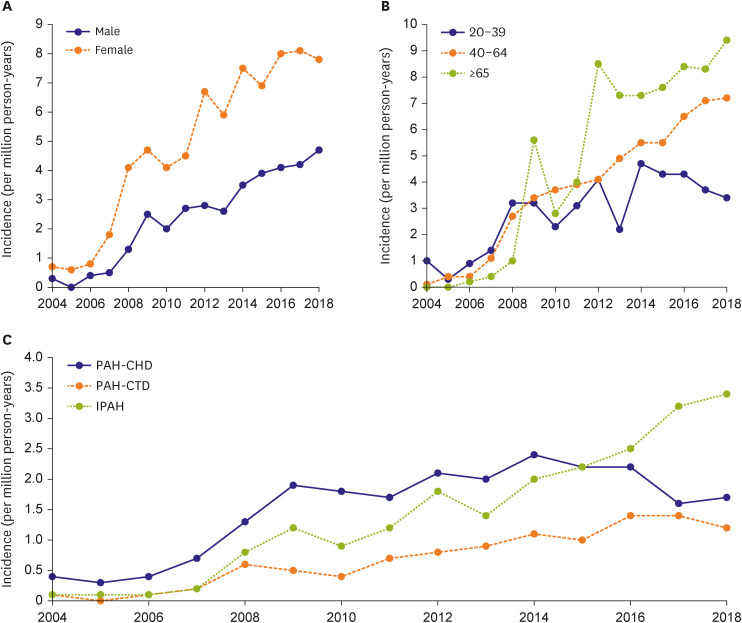
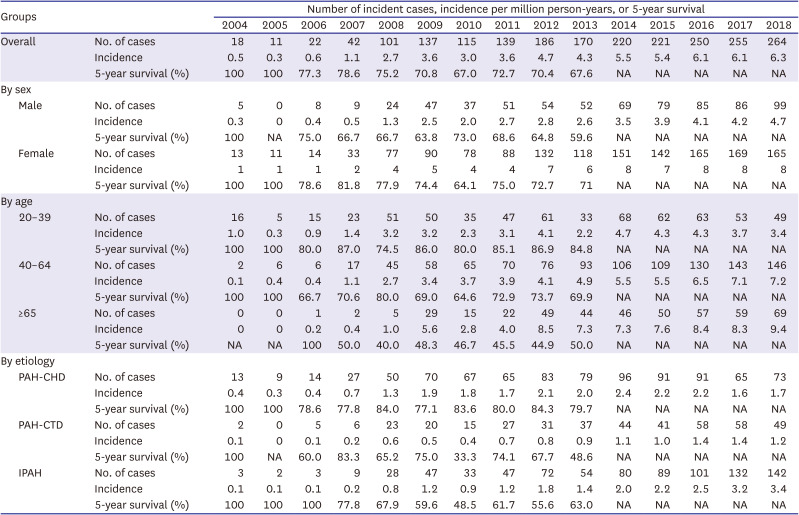

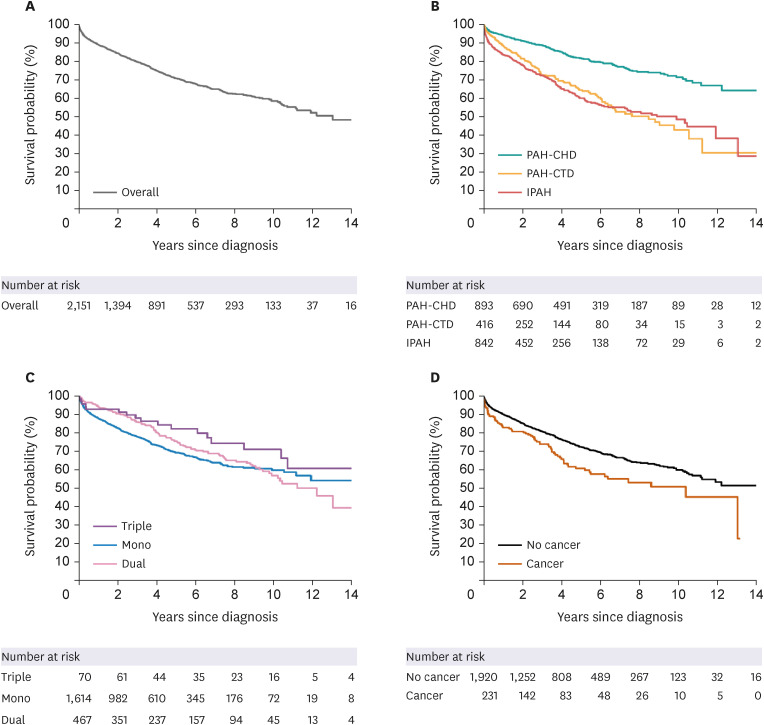
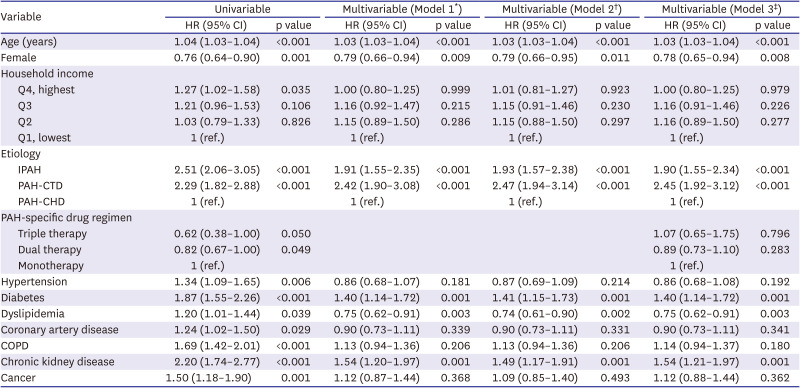




 PDF
PDF Citation
Citation Print
Print



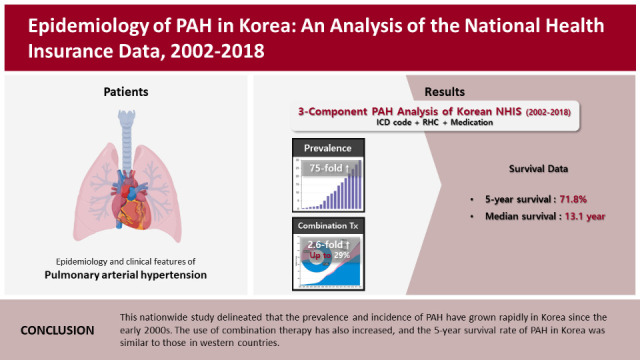
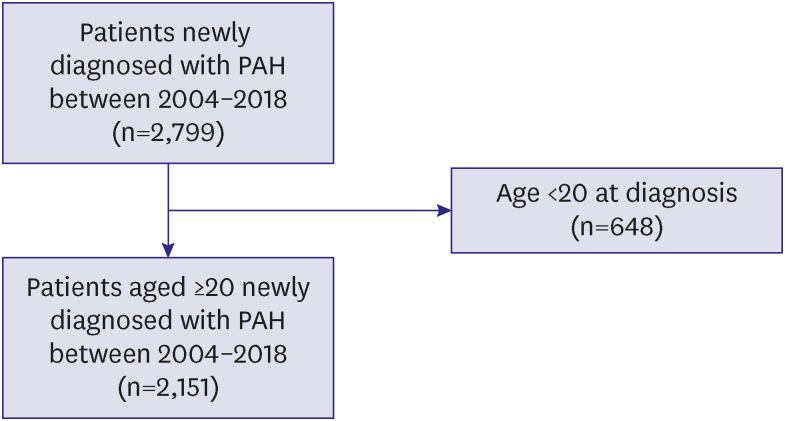
 XML Download
XML Download